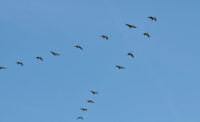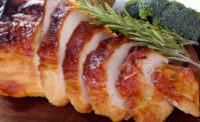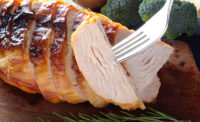Turkey’s resilience and wide geographic dispersal has maintained the supply reliability of turkey meat nationally, despite a leading production region suffering disproportionate losses to highly pathogenic avian influenza in spring 2015. Turkeys lost to the virus represented just 3 percent of the population of 240 million birds, concentrated in portions of a handful of states — few among the 14 states that annually produce 87 percent of the turkey supply. The individual financial impact on those growers in the upper Midwest has been the most apparent and immediate; however, government indemnities cover a significant portion of the loss, and processors typically also provide assistance to ensure the grower can continue in business without suffering a complete financial collapse.
Although turkey producers struggled to clean and disinfect barns and get back into production, progress has continued through the fall with restocking. Economist Dr. Thomas Elam says, “We have seen no indications that demand has declined this summer.”
Elam says it will likely be early 2016 before farms and plants are back in full production.
For this year, any return of the virus would already be too late to affect the 2015 Thanksgiving supply. The consumers’ preferred and widely available stock of frozen whole turkey was already produced and flash-frozen for quality by March, before the beginning of the avian influenza outbreaks. Distributors and supermarket chains long ago contracted for frozen whole turkey as promotional incentives to the Thanksgiving shopper. USDA’s monthly cold storage report of frozen whole turkey has consistently registered supplies closely matching last year’s inventories. Raised in separate barns, turkeys claimed by the virus were mostly larger toms, not the Thanksgiving dinner’s preferred-size turkey hens.
Spot shortages in grocers’ daily deli meat and tray packs have seemed to owe mostly to the limits in distribution arrangements. For restaurants, the price of accepting delivery occasionally outweighed the business decision that would have increased menu prices.
Plans in place
Return flights of fall migration by virus-carrying wild birds are certain, which has turkey growers and USDA preparing against the possibility of a recurrence of avian influenza infection in domestic poultry. Federal authorities have pre-positioned response teams and streamlined procedures with the goal of depopulating affected poultry within 24 hours. Growers have re-examined their barns against entry or off-farm spread of the virus.
USDA has gone forward with its intention to stockpile a vaccine for turkey. The decision to deploy the vaccine awaits the onset of the virus threat, the evaluation of effectiveness and trade implications. Vaccine is one of several tools — as an option — needed to protect poultry from disease, prevent suffering and protect their well-being.
Modern diagnostic methods provide the ability to distinguish for trade partners the difference from vaccinated birds and those that have the virus. The science of vaccine management has now progressed beyond international trade practices that until recently did not account for the ability to assure trading partners that disease was arrested and birds were protected by vaccine. U.S. trade representatives are actively encouraging trading partners to consider virus-free status gained from a strategy that includes effective vaccination.
Maintaining perspective
This is the National Turkey Federation’s 75th year, and the accumulation of experience from three generations brings the benefit of the long view toward this business. Soon after organizing, NTF faced its first challenge — the loss of nearly 2 million turkeys in the Midwest ice and snow of the 1940 Armistice Day storm. While the storm killed one-fourth of Nebraska’s turkey flocks, nearly 5 percent of the national supply of 33 million fresh whole turkeys was lost right before the Thanksgiving holiday. Farmers, always with an eye toward next season and fresh opportunities, would work hard and fill their barns again.
Supplying wartime troops with turkey increased our business, and then with the end of World War II, the peacetime business of supplying turkey would adjust to the sale of smaller birds for household ovens. The cycle of consumer demand would ride with innovation and the shift to year-round sales, and later, the move to deli meat, breakfast meats, and most recently ground turkey and select cuts such as turkey tenderloin. The present-day commitment to increasing consumer demand has carried forward the “20 by 2020” project this year, even as turkey growers and processors have kept a protective watch on newly placed poults.
The 20 by 2020 project has engaged restaurant chefs and registered dietitians on the flavorful and healthy selection of turkey on the menu and throughout grocery shelves. Chefs searching for new menu items are drawn to turkey meat that can be portioned, seasoned, marinated or paired as an unexpected menu item. Registered dietitians also need new lean, flavorful offerings to recommend with the convenience of ground turkey, sliced turkey breast or new dinner options such as turkey tenderloin.
NTF’s continued focus also remains on commitments for favorable policy where it most affects those who grow and process turkeys. Members of the National Turkey Federation continue to support removing the negative consequences of EPA’s corn ethanol mandate on feed costs. Uncertainty in the marketplace from the RFS corn ethanol mandate has caused volatility in the supply of corn available as the crucial ingredient in turkey and other livestock feed. In other areas of federal regulation, NTF has remained at work on the Veterinary Feed Directive, vigilant against disproportionate burdens on growers and processors, and practical in the regulation of turkey production.
Reflecting on the early challenges and the opportunities to be realized, NTF’s founder Charlie Wampler wrote some timeless words of wisdom: “The challenge to the National Turkey Federation is to look for opportunities to service this vastly changed and fast-moving industry. It is also a challenge to make happen the opportunities for greater service … to buckle down to the hard work and the new approaches of keeping pace. Certainly, there are challenges and problems — and we can be thankful for them. Because without problems, there would be no work to do and no great accomplishments to be achieved.” NP
State of the Industry 2015 segments
| Industry overview | Goes live Oct. 6 |
| Food Safety | Oct. 7 |
| Packaging | Oct. 8 |
| Beef (NCBA) | Oct. 9 |
| Beef (CAB) | Oct. 12 |
| Pork | Oct. 13 |
| Chicken | Oct. 14 |
| Turkey | Oct. 15 |
| Veal | Oct. 16 |
| Lamb | Oct. 19 |





Report Abusive Comment